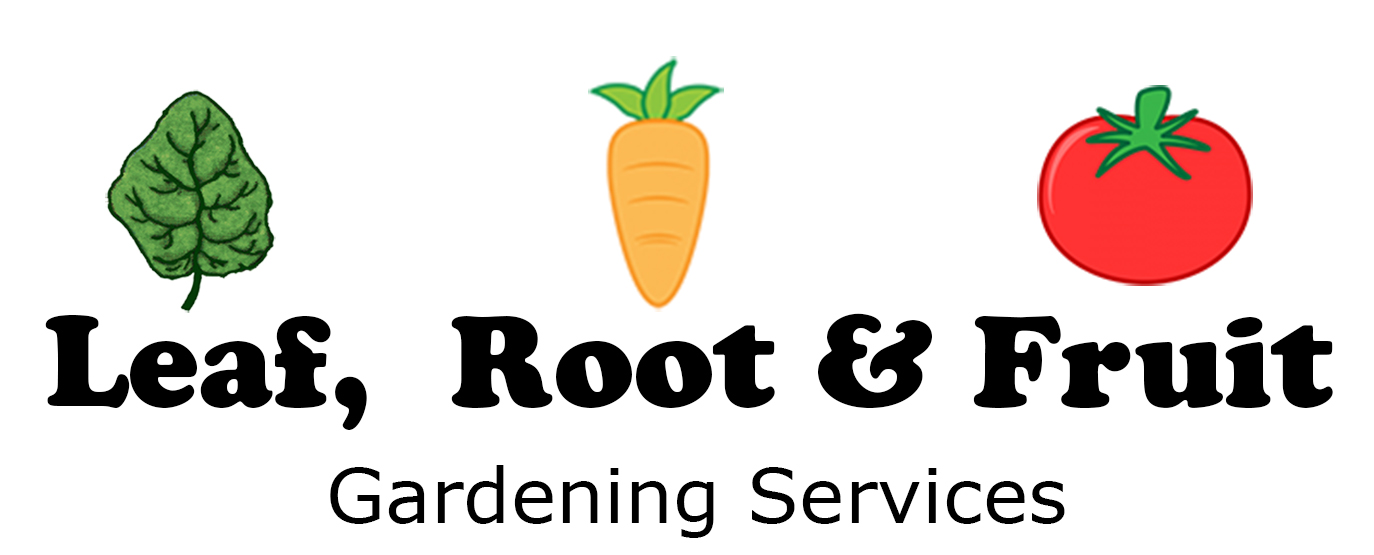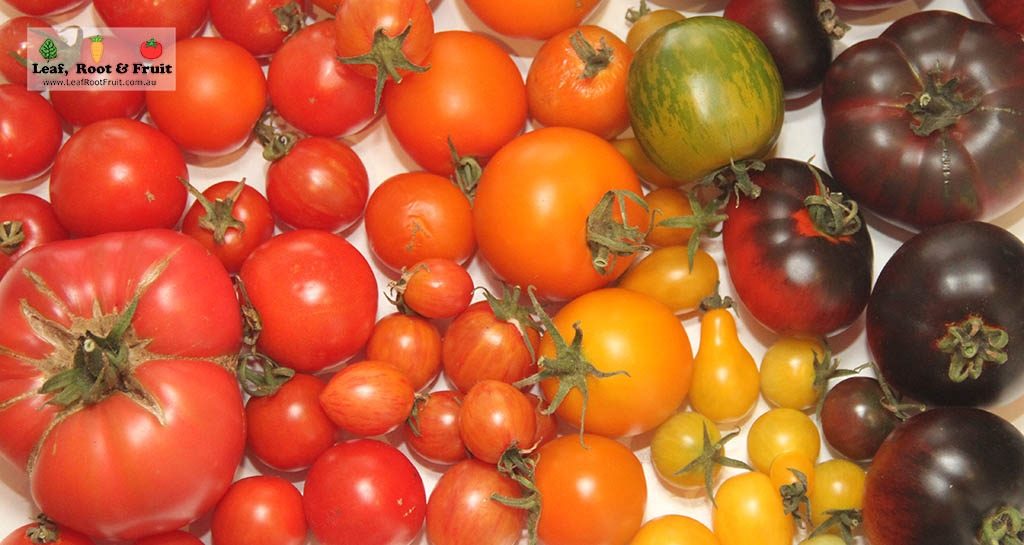
To me, nothing says Melbourne summer like the smell of tomato plants as you brush past them in the garden. The smell of tomato leaves (and basil) as I water the garden on a warm summer evening is amazing.
I’ve been growing tomatoes for decades, and have learnt much about them in the process. Using that experience, I’ve put together this guide to growing great tomatoes in Melbourne.
I also have a spring planting guide for Melbourne based gardeners covering all of the vegetables that you can grow at this time of the year.
How to select which tomato varieties to grow
The single most important factor when growing tomatoes (or any other veggies) is the choice of variety.
You wouldn’t try to win the Melbourne Cup with a donkey, you would use a thoroughbred with great genetics! To grow highly productive, tasty and nutrient dense tomatoes you need to choose varieties that exhibit those qualities.
There are a huge number of tomato varieties available to backyard gardeners in Melbourne. You can purchase literally hundreds of different types, different shapes and sizes from various online seed stores.
Here’s my thoughts on what to consider when selecting your varieties:
Colour of fruit:
Different coloured fruit have different anthocyanin and antioxidants, which are beneficial health wise. It’s a great idea, to grow a mixture of different coloured fruit, to help supply your family with a broader range of health benefits tastes and tomato experiences. A range of colours, sizes and shapes, also look great mixed together in a salad.
Birds and other pests tend to associate ripe fruit with red colours. So it’s an excellent idea to grow some yellow or green varieties together with red varieties. The birds will focus on the red “sacrificial crop” and leave the yellow and green ones alone.
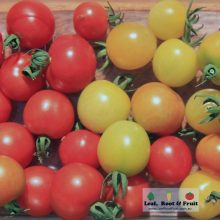
Determinate tomatoes vs indeterminate tomatoes:
Determinate varieties of tomatoes, also called “bush” tomatoes, are varieties that are bred to grow to a compact height (approx. 4 feet). Usually, the plants stop growing when fruit sets and ripen all of their crop at or near the same time (usually over a 2 to 4 week period), and then die. Advantages are that the plants require very little staking or support, and the produce can be harvested over limited time. This harvest can then be processed into passata, sauces, preserves, or dried with efficient time management.
Indeterminate varieties of tomatoes are also called “vining” tomatoes. They will grow and produce fruit until killed by the onset of cold winter temperatures. Most cherry tomatoes are indeterminate. They can reach heights of up to 3 to 4 metres although 1.5 to 2 metres is considered the norm. Indeterminate varieties will be blooming, setting new fruit and ripening fruit all at the same time throughout the growing season. This provides a continuous, extended crop of fruit. Indeterminate varieties require substantial staking for support and may require some pruning. The harvest can then be used over months, as fresh produce for family needs. The fruit can also be processed over a longer period of time.
Size of Fruit:
This is largely a matter of preference. I like cherry and smaller to medium sized tomatoes as they are prolific croppers, great in salads and perfect for eating straight off the vine. They also tend to have a more intense flavour than larger tomatoes. Children seem to love the smaller cherry tomatoes rather than the larger varieties, and are keen to eat them straight from the plants. It’s a great way to encourage children into the garden.
Larger tomatoes are great for slicing into sandwiches and are much easier to pick and handle than the smaller varieties. They are often better to store for longer periods of time.
Tomatoes for cooking:
If you’re planning on turning your delicious produce into some tasty pasta sauce, passata, salsa, tomato sauce or even drying them, then it’s best to grow tomatoes that have been bred for that purpose. Roma and San Marzano tomatoes are low in juice, seeds and pulp, which means the flavours when you dry or cook with them are far more intense. Many cooking tomatoes are also determinate, which means they’ll all ripen over a short period of time. This means you can pick and preserve in one or two big hits. As I mentioned in my guide to making passata, I hate washing up, so big batches suit me best. If you are growing tomatoes for saucing or cooking, then I suggest you grow a few vines to ensure that you have enough fruit to make it worth your time.

Tomato plant disease resistance:
I’ve noticed that some varieties of tomatoes are far more prone to diseases, such as early blight. Variety selection is the single most important aspect of growing your own food. One of my favourite tomatoes is Jaune Flammee. It produces lovely small orange fruit, often well before Christmas. However, the plant seems very susceptible to early blight and usually dies back by February. Other varieties such as Broad Ripple Currant keep producing well into winter and thrive in almost any soil condition. It can be difficult to find information on disease resistance. Experience and keeping a gardening diary, can help you to refine your variety selection over the years, so that you plant reliable croppers.
Some of my favourite tomato varieties
Broad Ripple Currant (Indeterminate, Cherry)
This tomato variety was found growing from the crack in a sidewalk in Broad Ripple, Indianapolis, Indiana in the mid 1900’s by John Hartman. It has masses of sweet yellow fruit to 10mm, grape like bunches, and doesn’t split, when left on vine. It survives harsh conditions and readily self-sows itself. This variety often produces well into winter.
Cherry Roma (Indeterminate, Cherry)
This miniature variety of the Roma tomato is packed full of strong, sweet flavour. Fruits are shiny, tear drop shaped. Expect a slightly lower yield than from other cherry tomatoes. Continues to produce late into the season. One of our favourites and likely to produce fruit before Christmas if planted out in late September or early October.
Black Cherry. (Indeterminate, Cherry)
Purple-black, and round, this plant produces an exceptionally sweet fruit. They are named for their dark, sweet and juicy flesh. They have very good disease resistance, that results from a strong and vigorous plant. Fruit can be harvested over a long (and late) cropping period. One of my absolute favourites!
Tigerella (Indeterminate, Medium Sized)
This plant produces enormous crops of delicious red-yellow striped tomatoes with exceptional flavour. It is one of the best yielding plants grown in Australia. The plant is an early cropper, but still takes a bit longer to fruit than some of the other varieties. It yields for months, with up to 20kg of fruit per plant! If transplanted under correct conditions, Tigerella reliably produces fruit prior to Christmas.
Jaune Flammee (Indeterminate, Medium Sized)
This jewel-coloured heirloom plant from France, produces fruit that is oval and medium sized, with a sweet, punchy flavour. The plant has a relatively low yield but is usually one of the first varieties to produce ripe fruit – well before Christmas. The vines are very susceptible to early blight so don’t rely on them to be overly productive after January.
Green Zebra (Indeterminate, Medium Sized)
Bred by the creator of hundreds of ‘modern heirlooms’, Tom Wagner. It has an in-built colour marker that produces yellow stripes, indicating when it is ripe. Firm, crack resistant fruits have zingy flavour. It’s early fruiting and the colour confuses the pests so the fruit is less prone to bird attacks. It is one of the most beautiful, modern heirlooms, now considered a classic. The plants have reasonable yields.
Wapsipinicon Peach (Indeterminate, Medium Sized)
Light, creamy-yellow, almost white fruit have superb taste and texture. The taste is complex, with its spicy, sweet, and very fruity flavour. The skin is slightly fuzzy like a peach, which apparently seems to deter fruit fly. This Iowa heirloom is named after the Wapsipinicon river
Burnley Bounty (Indeterminate, Slicing)
An Australian heirloom variety that produces 8-10cm round, red fruit. The vines produce very good yields of tasty, well balanced fruit. Plants are slightly more cold tolerant than some others. A late cropper.
Mortgage Lifter (Indeterminate, Slicing)
Radiator Charlie, the creator of Mortgage Lifter boosted his income from the clapped out pick-up trucks he repaired. He also bred beefsteak tomatoes, selling the plants at $1 each. He erased his mortgage in six years, and hence named one of his best tomatoes. A later cropper of large, tasty tomatoes.
Brandy Wine Pink (Indeterminate, Slicing)
Brandy Wine Pink are quintessential American, large beefsteak tomatoes. They are the reason all tomato sauce (ketchup) bottles in the USA are pink. The fruit is pinkish rather than red and is juicy and meaty. It is a late cropper, which loves a long, warm summer. The plant has a different leaf to most tomatoes – resembling a potato leaf.
Roma (Determinate, Cooking)
Since its introduction in 1955, Roma has been prized for its use in tomato paste, sugo, and sauces. Roma produces a large harvest of thick-walled, meaty, bright red and egg-shaped tomatoes. The fruit is about 3 inches long and with very few seeds. This tomato is not juicy and the flesh is thick and dry cooking down into a tasty sauce. Cooking intensifies the flavour. This is a great choice for the sun-drying of tomatoes. It’s not as juicy in the pan, compared with slicing tomatoes. The fruit freezes well for later cooking.
San Marzano (Determinate, Cooking)
San Marzano is superior to most other tomatoes for peeling and preserving as sauce and paste, pizza and pasta. The fruit is coreless and cylindrical and the vines are very productive. San Marzano fruit are usually double the size of Roma fruit, which means less fruit to pick and slice for the same volume of sauce!
When to sow and transplant tomatoes in Melbourne
One of the traditional gardening debates in Melbourne is when to transplant your tomato seedlings into the garden
Traditionalists such as my grandmother, insist that you need to wait until Melbourne Cup weekend to plant tomato seedlings out into the garden. The main fear is the tomato plants being wiped out by frost. I find that in suburban Melbourne, your tomatoes can actually be planted out much earlier than November. This is because the heat island effect via all the concrete in the inner suburbs, prevents most frosts. When growing tomatoes in Melbourne, I aim to plant tomato seedlings into gardens around AFL Grand Final weekend (very late September or early October).
I find that I have poor results transplanting earlier than the end of September. In Melbourne, planting your tomatoes after early December means that you won’t pick much fruit before the onset of winter.
You can also use phrenology to help you optimise your tomato panting.
Making an early start.
To have a successful early start, you often need to germinate seeds indoors, or in a greenhouse. This is because the soil in the garden is too cold to induce germination, and the young seedlings may be at the risk of frost.
I sow the bulk of my tomato seeds in the greenhouse in the last week of July. We then transplant around the last week of September/First week of October
Ignore those lovely looking seedlings that the larger hardware stores stock in August and early September. Transplanting them into the garden too early will probably result in stunted, slow growing plants or complete failure.
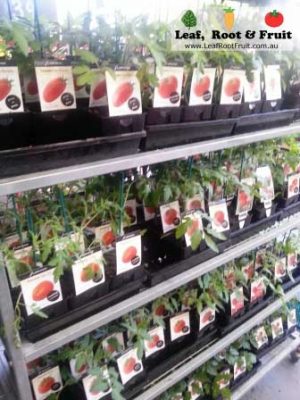
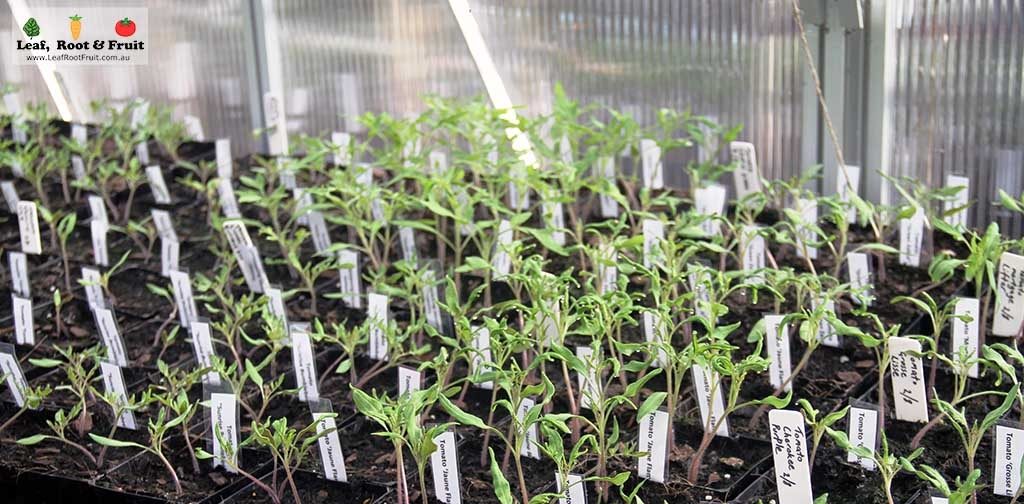
See my guide to different methods you can use to protect young seedlings and early vegetable crops for some ideas you might like to try.
You can also read my guide to making an early start in the vegetable patch. In that article I discuss how I determine when the optimal time to sow and transplant tomato seedlings in Kyneton.
Tips for ripening that elusive tomato before Christmas.
Many Melbourne gardeners like the challenge of producing a ripe tomato before Christmas. Sowing your tomato seeds in the greenhouse in July will give you a good chance at doing this. Grow early varieties – cherry tomatoes are easy to ripen before Christmas. Slicing tomatoes are much more of a challenge.
Avoid using nitrogen rich fertilisers. These grow strong healthy plants covered in foliage but do not induce the plant to flower and set fruit. To induce the plant to flower and set fruit early you need to make it panic and think it is going to die! This urges it to try to pass on its genes through seed.
I’ve found two reliable methods for inducing flowering in tomato plants:
- Letting the seedlings become very pot bound prior to transplant. The plant “thinks” that it has run out of room and starts to flower.
- Letting the potting mix become very dry so that the plant starts to wilt (then water it after a while) from drought stress.
Using a pinch of potash can also help to induce flowering in tomato plants. Although I never bother with this.
Once the plants have begun flowering they can be transplanted out into the garden and they will continue to flower and set fruit. The timing listed above for seed sowing and transplant, combined with using a small 0.45L pot means that most of my seedlings have germinated. The plants have become root bound enough, to induce flowering, before we transplant.
How to sow tomato seeds
Tomato seeds are relatively easy to propagate. If you only need a few tomato plants, then sow them into a small pot. If you plan to grow the seedlings on in the greenhouse for some time, then use a good quality potting mix. I’ve found that plants grown in poor quality potting mix become stunted and don’t transplant as well as stronger healthy plants.
Place the seeds on the soil surface and then sprinkle some more potting mix over the top.
Tomato seeds need warm soil to germinate. So place the pots in a warm spot. This could be:
- In a greenhouse
- Inside on a north facing window sill
- On top of the hot water service
- Next to the heater
Once the seedlings germinate keep an eye on their growth, if leaves become light in colour (or yellow) then they’ll need transplanting into a bigger pot and/or a bit of fertiliser to help them along. Letting a seedling become pot-bound can have its advantages (see above)
Soil preparation for growing tomatoes
Preparing your garden soil for growing tomatoes is relatively straight forward. I’ve already covered a general guide to preparing soil in your vegetable patch. The main thing with tomatoes, is to avoid is putting too much nitrogen rich compost into the soil. This will promote leaves at the expense of fruit. Therefore, it is a good idea to grow tomatoes where a nitrogen hungry plant such as broccoli or other brassicas have been grown over the winter. This depleted soil will the grow strong, healthy and productive tomato plants without high vigour. Read more about crop rotation of heavy and light feeding plants here.
If you have had fungal disease issues in the past, avoid growing tomatoes in the same area for a few years. Otherwise, I successfully grow tomatoes in the same space for several years in a row if no diseases issues have been noted. More on common diseases of the vegetable patch here.
Tomatoes are very prone to blossom end rot. This is caused by a lack of calcium in the cell wall. This lack of calcium can be due to a lack of calcium availability in the soil, or irregular watering. To overcome the first issue, you need to make sure the calcium is available to the plant. If you have a heavy sodic clay, then consider adding gypsum to the soil. Otherwise, a small amount of garden lime can help boost calcium levels.
Deep planting of tomatoes
When transplanting my tomato seedlings I use a method called deep planting. To do this I dig a hole about a foot deep and plant the seedling so the soil covers most of the plant stem. Only the top few leaves are visible above the soil surface. This enables the plant to develop more roots along the stem. It’s a good idea to remove any leaves that will be under the soil surface, as this can be a disease entry point.
I believe that having a tomato plant develop roots like this, makes it more resilient to the variations in soil moisture and temperature. My tomatoes certainly thrive using this method. If you are sowing your seeds in pots in the greenhouse, you can even deep plant the seedling each time to pot it up into a bigger pot.
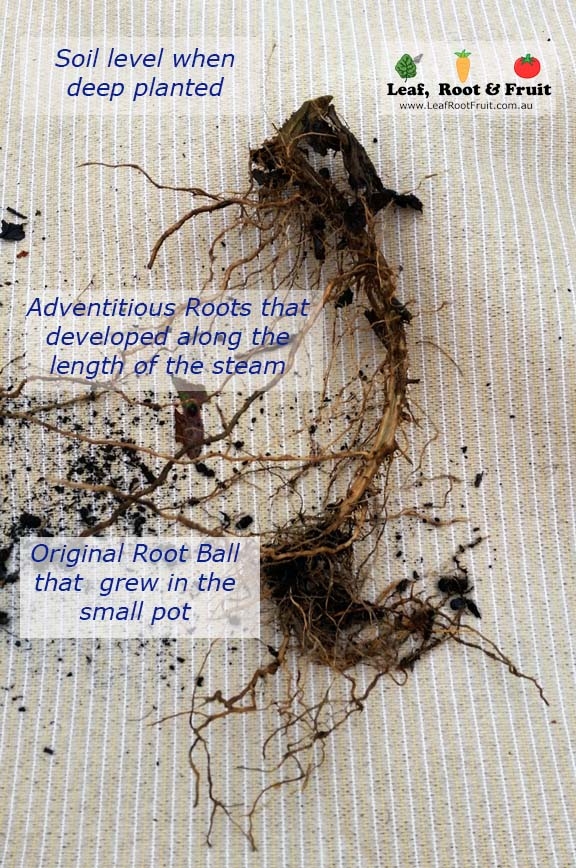
Staking methods for growing tomatoes
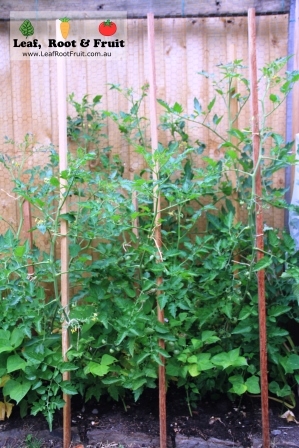
Your tomatoes don’t actually need staking. They will happily sprawl over the ground in a wild manner. However using stakes can help increase airflow to reduce disease. It can maximise your use of space and help damage to fruit from slugs, snails, rats and other pests.
There are lots of methods used for staking tomatoes. Here’s a few ideas:
- 3 to 4 Stakes with main leaders tied to them is a great way to grow tomatoes. Although they require you to keep on top of tying them up.
- Tomato tepees and frames can be great, although some models are a bit short and flimsy.
- Growing a large number of plants close together, enables stakes to be driven in regular intervals and a matrix of string tied between each stake. This lets the plants grow up through the string matrix and support themselves.
My Favourite Way To Stake Tomatoes
Over the years my trellis system for growing tomatoes has evolved. It started out as a series of stakes with a matrix of string wound through and around them, creating layers of webs for the plants to grow up and through.
Over time I decided to use layers of mesh laid horizontal above the garden bed. Currently I use rolls of mesh suspended with star posts driven into the ground or garden bed at intervals.
Read more about trellis systems for the vegetable patch here.
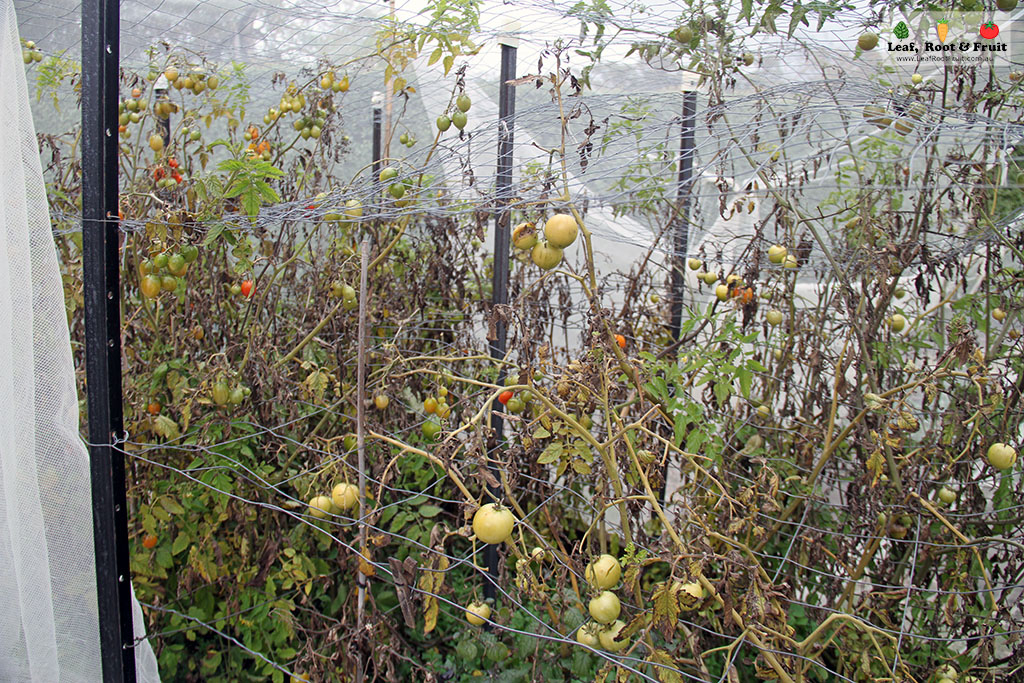
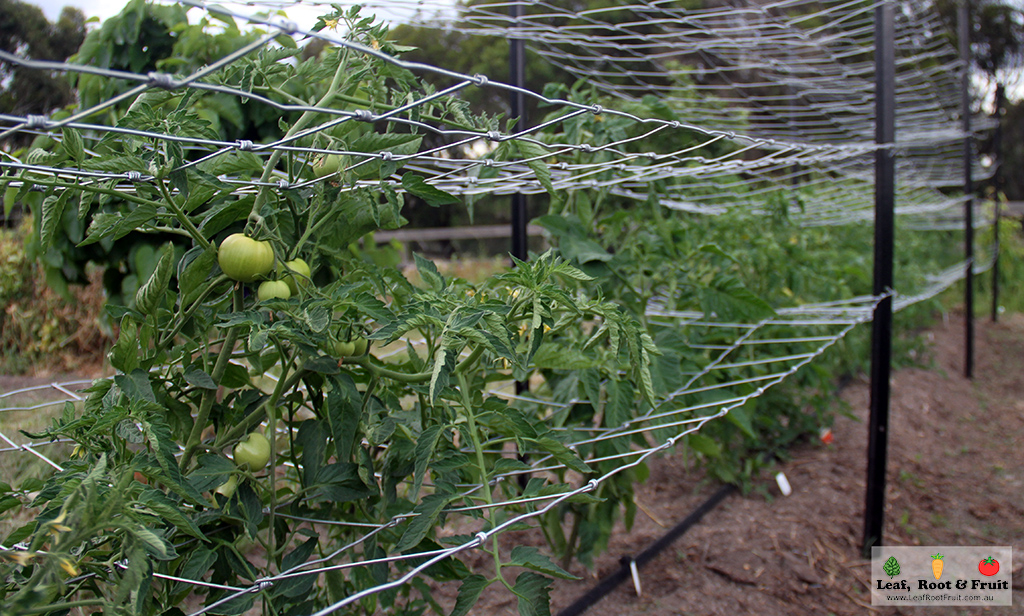

When I have finally set up our permanent raised beds, they will all be the same size. I plan to weld a framework that will sit on top of any of the beds. This framework will hold horizontal layers of reo mesh. The framework will enable polycarbonate panels to be inserted in spring to start plants early. These can be removed in summer and insect netting can be put in place to protect the fruit from birds and Queensland Fruit Fly. The insect netting also provides protection from light frosts.
Pruning of tomatoes
To prune or not to prune… That is the question! When I talk about pruning tomatoes I am referring to removing the lateral growth. The idea being that removing this growth directs energy into other parts of the plant and stops the base of the plant becoming congested.
I tend to start the season with enthusiastic pruning of lateral growth and focus the plant into growing three or four main stems. Once the plant grows larger, pruning out the laterals become a bit of a challenge due to the complexity of the plant and the fast growth rate. So midway through the season I usually abandon all pruning and the plants cope just fine with this.
Plants also seem to cope very well without pruning at all. So don’t over think the situation. Just keep them up off the ground and they’ll do the rest for you!
As the seedling grows, I usually remove all the lower leaves. Particularly any that touch the soil or may have soil splashed onto them when watering. This helps reduce the incidence of fungal diseases.
Harvest and Storage of tomatoes
For those of you without rat and bird problems, then harvesting of tomatoes is easy. Wait until they ripen and then pick the fruit off the vine. Try to retain the stalk in the fruit, as removal of the stalk can damage the fruit and reduce its shelf life.
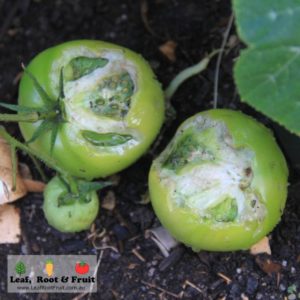
For those of you who share my rat problems, then you may need to develop a habit of picking your tomatoes before they are fully ripe. Once, I know that the rats are beating me to my precious crops, I begin picking the fruit as soon as the colour starts to change. I take the fruit inside and let it ripen at room temperature. This doesn’t seem to affect the flavour of the fruit much at all.
Part 26 of my series Vegetable Patch from Scratch discusses common pests of the vegetable patch, such as rats and birds. It suggests various strategies for reducing the impact they have in your patch.
Never store tomatoes in the fridge, it reduces their flavour. Store them at room temperature instead.
Tomatoes can be stewed, preserved, made into sauce, dried and of course, eaten fresh.
Do you have a sure-fire tip for growing tomatoes? Perhaps a favourite variety that you recommend we trial? Please share your experiences with us in the comments section below.
Would you like to know more?
Check out my spring planting guide for Melbourne based gardeners listing all of the veggies that you can grow at this time of the year.
I’ve put together a series called the Vegetable Patch from Scratch. It covers everything you need to know to prepare, plant and harvest your vegetables.
Want email reminders about when to plant tomatoes and other veggies out into the garden?
Sign up to my monthly newsletter for more great tips, inspiration and advice.
